These days, there’s one place in Shenzhen buzzing with excitement—a spot drawing huge crowds of locals. The reason? The 26th China International Hi-Tech Fair(CHTF) is in full swing!
This year’s CHTF, themed “Technology Leading Development, Industry Integration Driving Transformation”, is being held from November 14 to 16 at the Shenzhen World Exhibition & Convention Center (Bao’an).
Let’s follow the official SZPU account for a closer look at the cutting-edge innovations Shenzhen Polytechnic University is showcasing at this year’s fair!

SZPU’s booth is located at Hall 13, B10 in the Shenzhen World Exhibition & Convention Center (Bao’an).
From November 14 to 16, the 26th China International Hi-Tech Fair (CHTF), themed “Technology Leading Development, Industry Integration Driving Transformation”, is being held at the Shenzhen World Exhibition & Convention Center. SZPU has meticulously selected and organized 26 projects (including 21 faculty-led projects and 5 maker projects) and 6 STEM research platformsto participate in the exhibition. These projects cover areas such as integrated circuit design, key materials for integrated circuit packaging photoresists, new energy, intelligent manufacturing, and healthcare. The exhibition fully showcases SZPU’s capabilities in staying at the forefront of industrial development, supporting enterprise-driven innovation, facilitating the commercialization of research outcomes, and advancing scientific and technological innovation. It also highlights the university's latest achievements in innovation and entrepreneurship education.
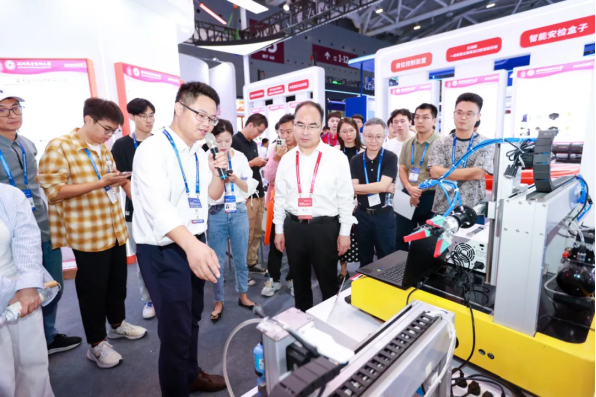
Xu Jianling, Deputy Party Secretary and President of SZPU, Attends the Exhibition and Listens to Project Presentations
Debut of AI-Powered Interactive Technology
A key highlight of SZPU’s booth at this year’s CHTF is the debut ofAI-powered interactive technology. The booth features a large3D digital hologram chamber and a metaverse digital avatar interactive cabinet.The 3D hologram chamber, a glasses-free 3D terminal display device, supports the creation and presentation of holographic images, offering visitors an immersive and intelligent interactive experience. Meanwhile, the metaverse digital avatar interactive cabinet allows attendees to create their own digital twins in real time, combining fun and cutting-edge technology to captivate audiences.

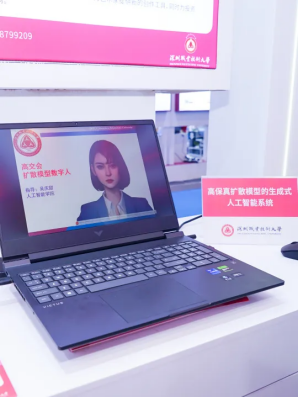
Five Star Projects Captivating the Crowd
At the exhibition, five standout projects drew significant attention from attendees: the development and industrialization of domestic photoresist materials for advanced semiconductor chip packaging, the edge intelligence all-in-one machine, flexible printed solar cells, the hydrogen-powered rescue boat for aerial emergencies, and the upper limb rehabilitation exoskeleton robot for hemiplegia recovery.
Development and Industrialization of Domestic Photoresist Materials for Advanced Semiconductor Chip Packaging
At the exhibition, the projects on advanced semiconductor chip packaging and the development and industrialization of domestic photoresist materials, along with the edge intelligence all-in-one machine, flexible printed solar cells, hydrogen-powered rescue boat for aerial emergencies, and upper limb rehabilitation exoskeleton robot for hemiplegia recovery, drew significant attention from attendees.
Development and Industrialization of Domestic Photoresist Materials for Advanced Semiconductor Chip Packaging
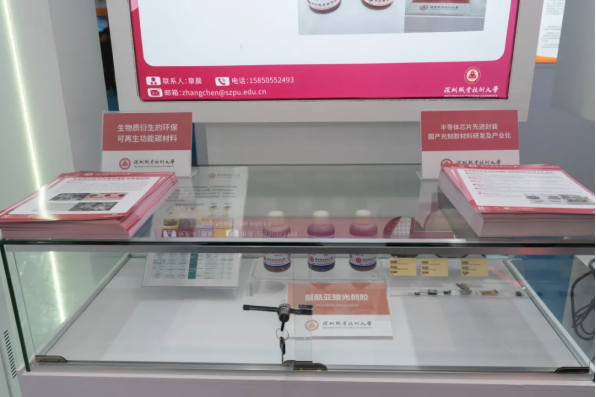
The project, led by SZPU’s Integrated Circuit Key Materials Research Team, aims to break the international monopoly on photoresist materials in the advanced packaging field of semiconductor chips. The team has successfully developed severalnegative and positive PSPI photoresist materials, which are now being applied in small batches at companies such as Deep Semiconductor. These materials play a critical role in IC chip construction, with applications across multiple layers, including redistribution layers, stress buffer layers, alpha-particle shielding layers, chip passivation layers, and interlayer dielectric insulation layers. They form a crucial foundation for improving the performance and reliability of semiconductor packaging.
Edge Intelligence All-in-One Machine

The Ship Collision Intelligent Warning Systemis an edge intelligence hardware-software integrated product and the first in the industry to apply edge intelligence technology to bridge collision prevention scenarios. By utilizing an edge intelligence platform, the system enables ship trajectory calculation, drift warning, height warning, speed warning, and on-site device linkage control. The system features advanced capabilities such as radar-vision fusion algorithms, radar-vision linkage control, ship identification via facial recognition technology, predictive trajectory analysis, on-site network disconnection alerts, algorithm updates, remote equipment maintenance, and status analysis.
Flexible Printed Solar Cells

Solution printing technology is a key industrial manufacturing method widely used in various printed electronics industries. It offers advantages such as low cost, high material utilization, and high precision in patterning. As a direct-writing technique, printing demonstrates significant industrialization potential and is expected to play a crucial role in the commercialization of perovskite solar cells. Theflexible printed solar cell project employs solution printing technology, combining composition control with interface engineering to enable the efficient fabrication of perovskite thin films on various substrates. The project conducts systematic analysis and research on the functional layers of perovskite solar cells, with a particular focus on the growth and regulation of perovskite thin films under room-temperature conditions.
Hydrogen-Powered Flying Rescue Boat
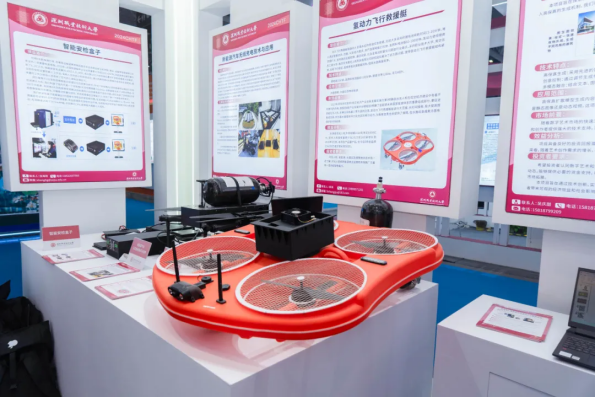
The hydrogen-powered flying rescue boatis designed for rapid emergency response in water rescue scenarios. Traditional lithium battery-powered models typically offer a flight duration of only 15-20 minutes, which is insufficient to meet the demands of search and rescue operations in terms of time, range, and power. This product offers a lithium battery version with a flight time of 15 minutes and a hydrogen fuel cell version with a flight duration of 60-100 minutes.
While hydrogen power significantly expands the range of search and rescue operations, it introduces challenges such as remote control, communication, and the lightweight design of hydrogen fuel cells—key pain points in the industry. A collaborative research team from Shenzhen Polytechnic University, Nanjing University of Information Science and Technology, and Nanjing Kaitianyan UAV Technology Co., Ltd. has addressed these issues. The resulting hydrogen-powered flying rescue boat features a compact structure, stable long-distance flight, and enhanced water rescue capabilities, effectively reducing risks and improving the efficiency of surface water rescue operations.
Upper Limb Rehabilitation Exoskeleton Robot for Hemiplegia Recovery

Theupper limb rehabilitation exoskeleton robotis designed to assist medical staff in providing rehabilitation therapy for patients with upper limb hemiplegia. It uses sensors to detect the patient’s normal upper limb movement patterns and applies these to rehabilitation training for the affected limb. The robot can collect real-time resistance data from the patient’s hemiplegic limb during movement, providing valuable scientific reference data for adjusting future rehabilitation plans. This innovation holds significant medical and social value.
"SZPU Makers" Projects Aligned with Market Needs
This year’s CHTF features five“SZPU Makers” projects, all with independent intellectual property rights, closely aligned with market demands and boasting significant commercial potential. Among them, theHigh-Precision UWB Positioning Systemstands out. Through a self-calibrating system, it collects real-time data to autonomously network base stations. Using a proprietary preemptive tag positioning solution, the system reduces tag power consumption to just 15mAh, enabling a battery life of 1-3 months. This innovation enhances deployment efficiency while reducing labor costs. The system allows real-time tracking of the positions of base stations and tags, supports OTA (over-the-air) upgrades, and offers a more convenient deployment process. By adopting a preemptive positioning solution, it minimizes power usage and enables remote upgrades, making it adaptable to a wide range of industries.
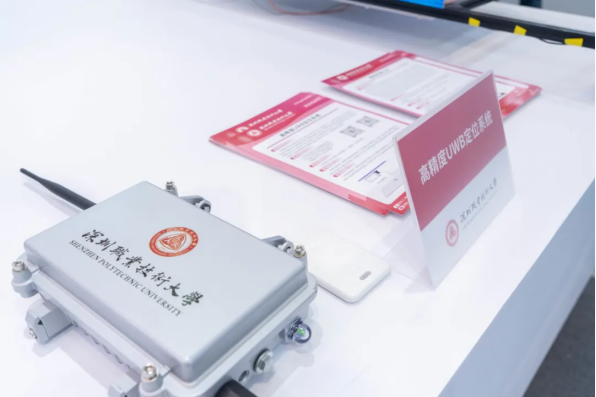
Six Major Research Platforms Driving Industrial Upgrades
This year, SZPU showcasedsix STEM-focused research platformsat the CHTF: the Hoffman Advanced Materials Research Institute, the Institute of Intelligent Science and Engineering, the Institute of Intelligent Manufacturing Technology, the Integrated Circuit Key Materials Research Institute, the Guangdong-Hong Kong-Macao Greater Bay Area Artificial Intelligence Application Technology Research Institute, and the New Energy Vehicle Technology Research Institute. These high-level applied research institutes aim to support industrial upgrades and innovation through cutting-edge applied technology research.

Located in China’s National Innovation Demonstration Zone and the "City of Innovation", Shenzhen Polytechnic University (SZPU) is committed to establishing itself as a hub for applied technology innovation and research. The university adheres to a"grounded yet forward-reaching" approach to applied technology development, integrating education, science, and talent to tackle bottlenecks in the development of high-end industries in Shenzhen and across the nation. Aiming to contribute to the Guangdong-Hong Kong-Macao Greater Bay Area’s ambition of becoming a globally influential international innovation center, SZPU actively integrates itself into the region’s urban, industrial, and economic development. By positioning itself within the chain of scientific technologization and technological industrialization, SZPU emphasizes an applied research orientation to comprehensively support national and regional innovation-driven development. The university strives to be a vital source of technological innovation driving the Greater Bay Area’s advancement in innovation and development.
Planning: Party Committee Publicity Department
Source: Office of Scientific Research
Photography: Zhang Lei, Yao Jiewen, Li Jinhong
Editing: Liu Rujia, Zhong Wan
Supervised by: Xiao Hanyue

 School Motto:
School Motto:
 Search
Search
 School Motto:
School Motto:
 Search
Search